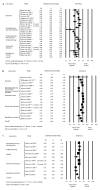Effect of hand hygiene on infectious disease risk in the community setting: a meta-analysis
- PMID: 18556606
- PMCID: PMC2446461
- DOI: 10.2105/AJPH.2007.124610
Effect of hand hygiene on infectious disease risk in the community setting: a meta-analysis
Abstract
To quantify the effect of hand-hygiene interventions on rates of gastrointestinal and respiratory illnesses and to identify interventions that provide the greatest efficacy, we searched 4 electronic databases for hand-hygiene trials published from January 1960 through May 2007 and conducted meta-analyses to generate pooled rate ratios across interventions (N=30 studies). Improvements in hand hygiene resulted in reductions in gastrointestinal illness of 31% (95% confidence intervals [CI]=19%, 42%) and reductions in respiratory illness of 21% (95% CI=5%, 34%). The most beneficial intervention was hand-hygiene education with use of nonantibacterial soap. Use of antibacterial soap showed little added benefit compared with use of nonantibacterial soap. Hand hygiene is clearly effective against gastrointestinal and, to a lesser extent, respiratory infections. Studies examining hygiene practices during respiratory illness and interventions targeting aerosol transmission are needed.
Figures


References
-
- Aiello AE, Larson EL. What is the evidence for a causal link between hygiene and infections? Lancet Infect Dis. 2002;2:103–110. - PubMed
-
- Perencevich EN, Wong MT, Harris AD. National and regional assessment of the antibacterial soap market: a step toward determining the impact of prevalent antibacterial soaps. Am J Infect Control. 2001;29: 281–283. - PubMed
-
- Muller MP, McGeer A. Febrile respiratory illness in the intensive care unit setting: an infection control perspective. Curr Opin Crit Care. 2006;12:37–42. - PubMed
Publication types
MeSH terms
Substances
LinkOut - more resources
Full Text Sources
Other Literature Sources
Medical

